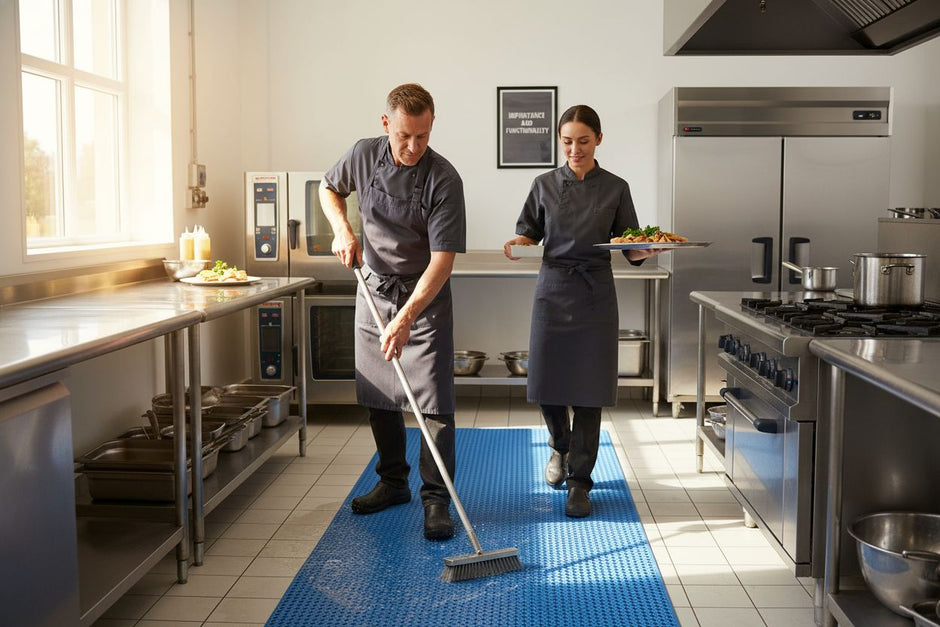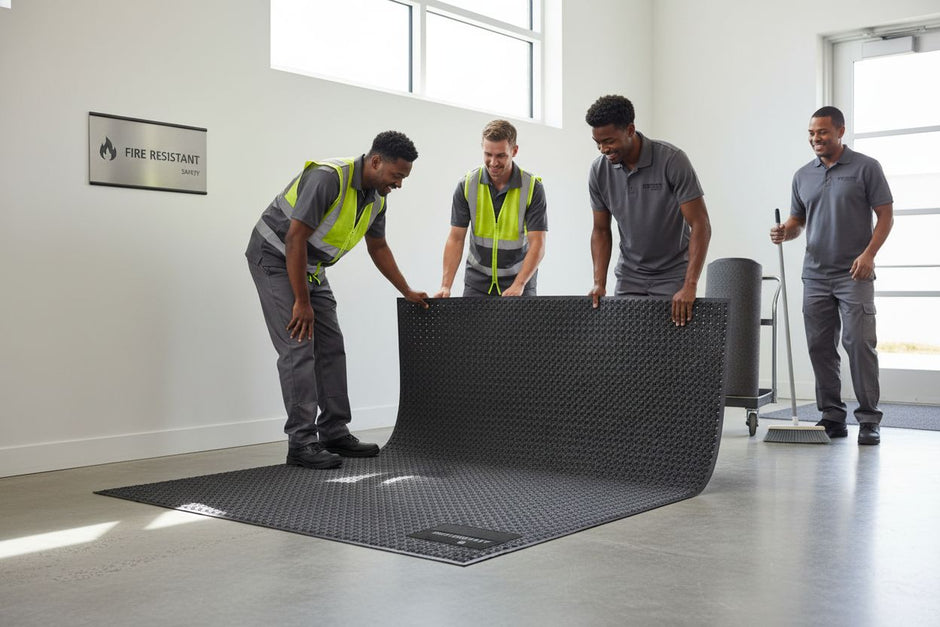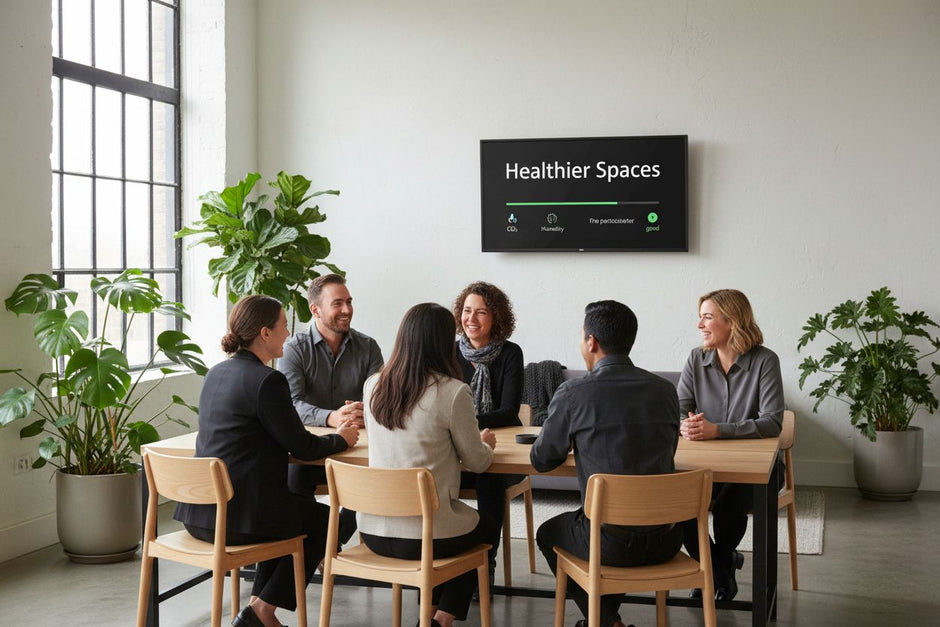The very foundation of your commercial gym—its floor—is where success begins. It's the one surface that touches every member's workout, dictating their safety, protecting your expensive equipment, and shaping the entire vibe of your space. Choosing the right commercial gym flooring isn't just about looks; it's a critical investment in the health of your business.
Building Your Gym From The Ground Up
Think about it: the floor is arguably the most essential piece of equipment in any gym. Every member uses it, every single time they train, from the second they step inside. A bad choice here can lead to a domino effect of problems—cracked subfloors, damaged dumbbells, and a higher risk of slips and falls that can turn into serious liabilities. But get it right, and the surface becomes a silent partner, boosting performance, safeguarding your assets, and making the member experience that much better.
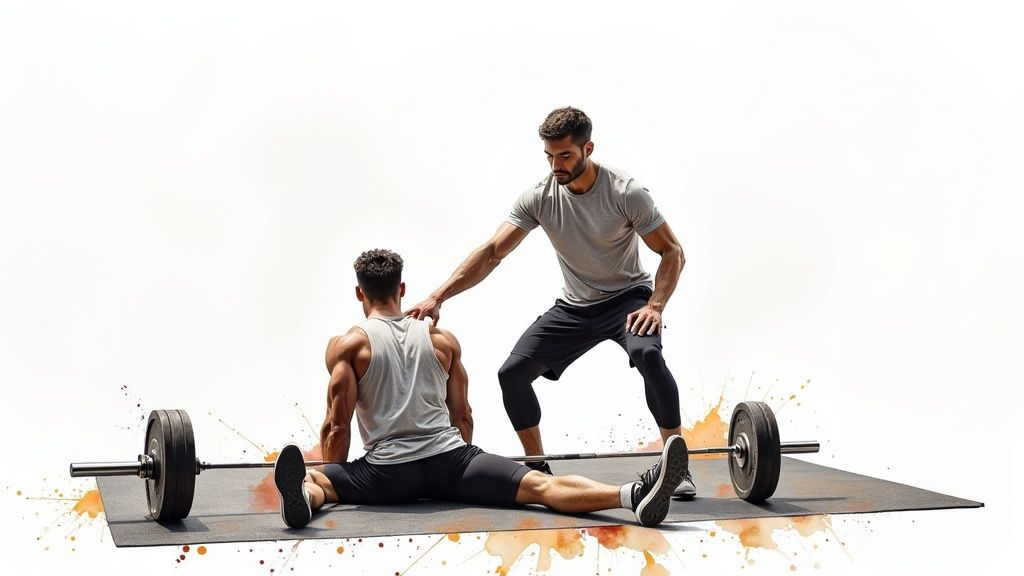
When you're mapping out a new facility, selecting the flooring deserves the same careful consideration as picking out squat racks and treadmills. The needs of a high-octane training center built for Olympic lifting are worlds apart from those of a serene yoga studio. One demands extreme shock absorption to handle heavy, repeated drops, while the other needs a comfortable, stable surface for grounded poses.
Foundational Planning For Success
Before you even glance at material samples, you have to nail down the primary purpose of your facility. Getting this foundational planning right from the start helps you sidestep expensive mistakes later on. When you're building a commercial gym from the ground up, the scope of planning is massive, much like the comprehensive engineering services seen in the new build Stranraer Water Sports Centre project. Just as a project of that scale needs expert oversight, your flooring choice requires a strategic, well-thought-out approach.
Here's how to get started with an actionable plan:
- Step 1: Zone Mapping. Grab a floor plan of your facility and physically draw out the different zones. For example, label a 1,000 sq ft area as "Free Weights," a 500 sq ft section as "Cardio," and a 300 sq ft corner as "Functional Training." This visual map makes it clear you don't need a single flooring type.
- Step 2: Budget Allocation. Once you have your zones, assign a per-square-foot budget to each. You might allocate a higher budget for high-density rubber in the free weight zone and a more cost-effective option for the lower-impact cardio area. This prevents overspending.
- Step 3: Acoustic Assessment. If your gym is on the second floor of a commercial building, sound dampening becomes a top priority. Your plan should specify flooring with a high IIC (Impact Insulation Class) rating for the weightlifting area to prevent noise complaints from the tenants below, protecting your lease and business relationships.
The right flooring does more than just look good—it acts as the silent partner in your members' fitness journey, providing the safety and stability they need to push their limits.
Answering these questions first ensures your investment doesn't just meet today's demands but is also ready to support your gym's growth for years to come.
Decoding The Best Materials For Gym Flooring
Picking the right flooring for your commercial gym is a lot like choosing the right tires for a race car. Get it wrong, and you’re looking at poor performance, safety risks, and expensive replacements down the line. But get it right? You’ll have the grip, durability, and support needed to create a world-class fitness environment. Not all materials are built the same, and knowing their strengths is the secret to building a gym that lasts.
This breakdown slices through the options, starting with durability—the most critical factor for any high-traffic facility.
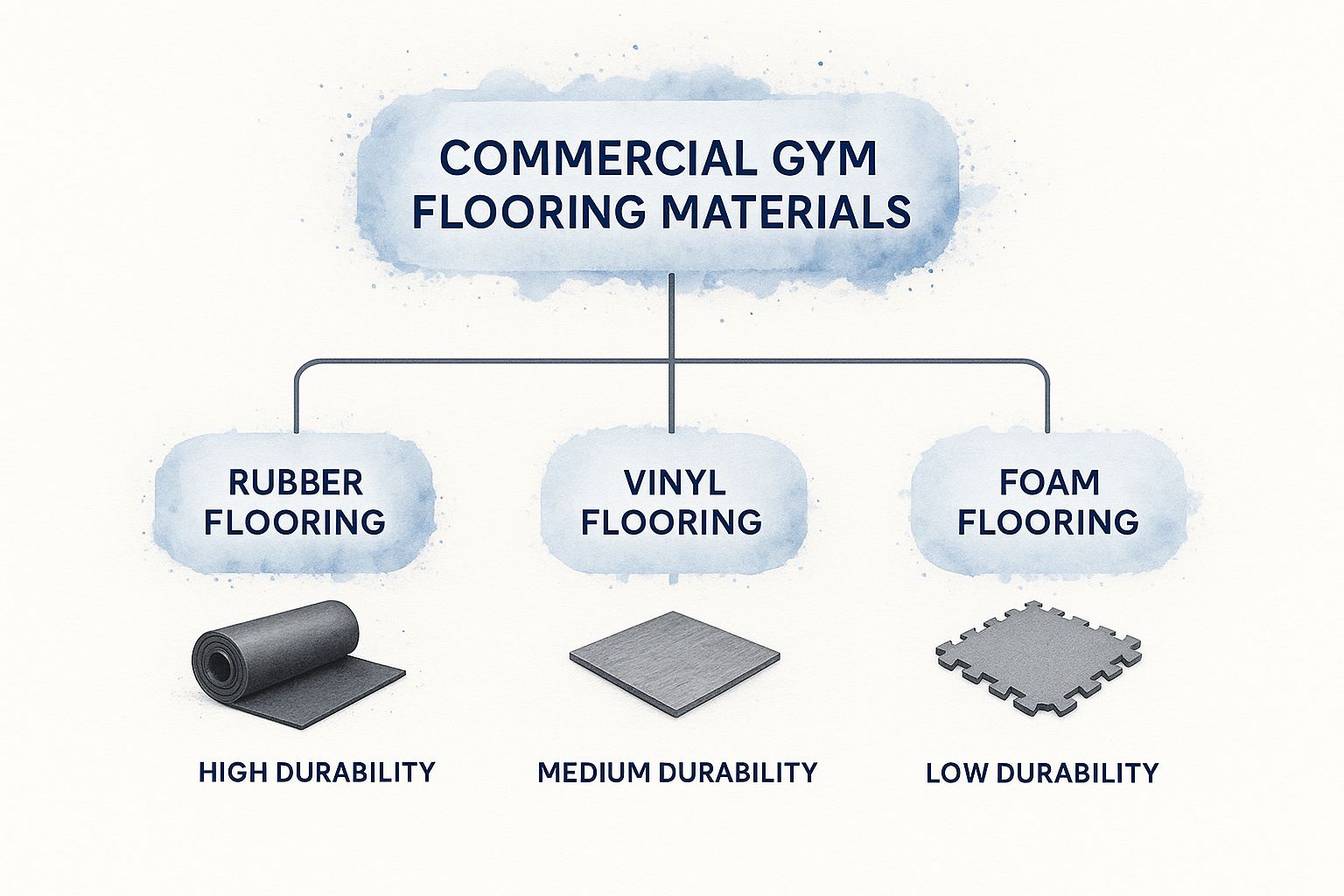
As you can see, rubber is the undisputed king when it comes to durability, making it perfect for your most demanding gym zones. On the other end of the spectrum, foam is best reserved for low-impact, temporary setups.
To make the decision process a bit easier, here's a quick side-by-side look at the top contenders.
Commercial Gym Flooring Material Comparison
| Material Type | Primary Use Zone | Durability Rating | Shock Absorption | Maintenance Level |
|---|---|---|---|---|
| Rubber | Free weights, strength training, high-traffic | Very High | Excellent | Low to Medium |
| Artificial Turf | Functional fitness, sled pushes, agility | High | Good | Low |
| Luxury Vinyl Tile (LVT) | Lobbies, locker rooms, cardio areas | Medium to High | Low | Low |
This table gives you a bird's-eye view, but the real magic is in understanding why each material works best for its specific job. Let's dive a little deeper into the top three.
Rubber Flooring: The Indisputable Champion
When it comes to the free weight area and heavy strength training zones, rubber flooring is in a league of its own. Whether you choose versatile rolls or easy-to-install tiles, its main job is to act as a powerful shock absorber. Think of it as a protective shield for both your expensive equipment and your building's subfloor.
High-density rubber is engineered to eat up the massive force from a dropped barbell or dumbbell. This does two critical things: it stops the weight from getting damaged, and it protects your concrete subfloor from cracks that can cost a fortune to repair. Plus, its dense structure is a natural sound deadener—a huge win if your gym is in a shared building where noise complaints can become a real headache.
Actionable Takeaway: When budgeting for a new strength area, always prioritize high-density rubber flooring. The upfront cost might be a bit more, but it’s an investment that prevents far more expensive, long-term damage to your equipment and your building’s foundation.
It's no surprise that rubber is a top choice in modern gyms for its sheer toughness and slip resistance. While other materials have their place, emerging tech like smart flooring with embedded sensors is also starting to shake things up, offering real-time data to boost performance and safety. You can discover more insights about sports flooring trends on kieferusa.com to see what's on the horizon.
Artificial Turf: The Functional Fitness Go-To
For any zone dedicated to dynamic, multi-directional movement, artificial turf is the clear winner. It’s the go-to surface for functional fitness, agility drills, and the ever-popular sled push. Its texture is specifically designed to provide the perfect blend of grip and glide—a combo that’s essential for both performance and safety.
The synthetic grass blades give athletes just enough traction for solid footing during sprints, lunges, and cone drills, which drastically reduces the risk of slips. At the same time, the surface is smooth enough for a weighted sled to glide right over it without catching or tearing the material. This dual functionality makes it an incredibly efficient use of your gym space.
Here’s a perfect example of how to put it to work:
- Real-World Example: A CrossFit box wants to add a dedicated 50-foot lane for sled pushes and conditioning work without disrupting the main lifting area.
- Actionable Solution: They install a strip of padded artificial turf right next to their rubber-matted weightlifting platforms. This creates a visually and functionally separate zone, letting one group do sled work while another focuses on Olympic lifts safely. The turf’s built-in cushioning also helps reduce stress on athletes' joints during high-impact moves like box jumps, directly improving member safety and workout quality.
Luxury Vinyl Tile: Where Aesthetics Meets Practicality
The first and last places your members see are your reception area, locker rooms, and cardio zones. These spaces need a flooring solution that’s welcoming, reflects your brand, and is ridiculously easy to keep clean. This is where Luxury Vinyl Tile (LVT) really shines.
LVT brilliantly merges the high-end look of natural materials like wood or stone with the rugged, practical benefits needed in a commercial gym. It's 100% waterproof, making it the perfect choice for locker rooms and areas prone to spills. Its non-porous surface makes cleaning a breeze—a quick wipe is usually all it takes to handle sweat and dirt, keeping the space hygienic and looking sharp.
The design options with LVT are virtually endless. You can create a warm, inviting entryway that matches your brand's style or even have custom logos and patterns printed directly into the floor.
- Real-World Example: A boutique fitness studio wants to cultivate a premium, spa-like atmosphere in its entrance and changing rooms. They opt for an LVT with a realistic light oak finish.
- How-To & Benefit: This single choice instantly elevates the space, justifying a higher membership price and enhancing the member experience from the second they walk through the door. The benefit to the business is not just aesthetic; because the LVT is so easy to clean, they reduce staff cleaning time by 30 minutes daily, saving on labor costs while maintaining a pristine environment.
Matching The Right Floor To Each Gym Zone
A great gym isn't just one big, open room; it's a collection of specialized zones, and each one has a totally different job to do. Your flooring needs to be just as specialized. Slapping down a single, one-size-fits-all surface is a classic mistake—a surefire recipe for premature wear and tear, potential injuries, and a space that just doesn't perform.
Think of your gym layout like a strategic map. You need to match the right surface to the right activity. This zone-based approach is about more than looks; it’s about boosting safety, enhancing member performance, and protecting your investment for the long haul.

It’s the secret to creating a gym that feels intuitive and works flawlessly for your members.
Free Weight And Olympic Lifting Zones
This is the high-impact heart of your gym. It's loud, it's intense, and it demands the toughest protection you can find. The floor here has one primary job: to absorb the massive, repetitive force of dropped barbels and dumbbells. Skimping in this area is not an option. One bad drop could crack your concrete subfloor, a repair that can be catastrophically expensive.
For this reason, high-density rubber flooring is completely non-negotiable.
- Actionable Strategy: Lay down rubber tiles or rolls with a minimum thickness of 8mm. For dedicated Olympic lifting platforms where heavy weights are dropped from overhead, you absolutely need to upgrade to 12mm or thicker material. This gives you the serious shock absorption required to protect both your gear and your building's structure.
- Real-World Example: A local powerlifting gym was seeing premature wear on its barbels and noticed chipping on the concrete floor beneath its mats. They swapped their thin, worn-out flooring for interlocking 10mm high-density rubber tiles. The benefit was immediate: no more subfloor damage, a huge reduction in noise bleeding through to their neighbors, and members felt more confident lifting heavy, knowing the floor could handle it.
Functional Fitness And Agility Areas
Functional fitness zones are the Swiss Army knife of the gym. One minute a member is sprinting, the next they're pushing a heavy sled, and then they're doing box jumps. This area needs a surface that can handle it all without getting shredded.
Padded artificial turf is the perfect solution for these multi-purpose zones. It offers a unique blend of grip for quick agility drills, hardcore durability for dragging heavy equipment, and crucial cushioning to reduce joint impact. The texture allows sleds to glide smoothly instead of tearing up the surface, which is a common failure point for standard rubber floors.
Here's how this directly benefits your members and your business:
- How-To for Grip: The grass-like fibers give members excellent footing for sprints and sudden changes in direction, helping to prevent slips and improve performance.
- How-To for Sled Work: The smooth yet tough surface is specifically built to withstand the intense friction from heavy sled pushes and pulls, protecting your flooring investment.
- Benefit of Joint Protection: Integrated padding helps absorb the shock from plyometric exercises like burpees and box jumps, making workouts safer and reducing member fatigue and risk of injury.
Cardio Machine Areas
The floor under your fleet of treadmills, ellipticals, and stationary bikes faces a different set of challenges. It doesn't need to absorb massive impacts, but it does need to be incredibly durable, stable, and a breeze to maintain. Heavy cardio machines can leave deep indentations or cause thinner flooring to buckle and warp over time.
For these spots, low-profile rubber rolls or Luxury Vinyl Tile (LVT) are excellent choices. Their dense, solid construction stands up to the machine’s weight without compressing, providing a rock-solid platform. Even more importantly, these surfaces are non-porous and incredibly easy to clean.
- Actionable Tip: Place LVT or thin rubber rolls under your cardio equipment.
- Benefit: The non-porous surface means sweat and spilled water can be wiped up in seconds with a simple disinfectant wipe. This massive operational win saves your staff valuable time during daily cleaning routines and ensures the cardio deck always looks pristine and hygienic for your members.
Group Fitness Studios
Studios for classes like aerobics, dance, or yoga need a floor that gives something back to the user. The two most important words here are energy return and cushioning. A hard, unforgiving surface drains energy, leads to fatigue, and dramatically increases the risk of joint strain during high-impact classes.
This is where specialized flooring options truly shine.
- Option 1: Sprung Wood Floors. Long considered the gold standard for dance and aerobics, these floors have a built-in suspension system. It provides a slight "give" that absorbs impact and actually returns energy to the user, helping them feel lighter on their feet.
- Option 2: Cushioned Vinyl. This is a more modern and often more affordable alternative. It combines the toughness of vinyl with a foam or rubber backing that provides the cushioning needed for high-intensity workouts. The comfort it provides can make a real difference in member fatigue, a concept we explore more in our guide to anti-fatigue mats and your health.
- Real-World Example: A yoga studio was receiving feedback that holding poses on their old, hard floor was uncomfortable. They installed cushioned vinyl flooring. The immediate benefit was a surge in positive member feedback, improved class retention, and the ability to market their studio as having a "joint-friendly, premium surface."
Critical Factors Before You Make A Purchase
Picking the right commercial gym flooring involves more than just choosing a color you like. If you want an investment that pays off for years to come, you need to dig into the technical details that separate a high-performance floor from one that will fail before its time. Think of this as your essential pre-purchase checklist.
The demand for specialized, high-performance surfaces is blowing up. In fact, the gym flooring market was valued at around USD 1.29 billion in 2022 and is expected to hit USD 2.14 billion by 2033. This isn't just a trend; it's a direct response to the need for flooring that can handle punishing workouts and prevent injuries. It’s also exactly why getting the technical specs right is so important. You can read the full research about the exercise flooring market to see the data for yourself.
Thickness and Density
It's a classic rookie mistake: assuming thicker automatically means better. While thickness certainly contributes to cushioning, the real hero is density. This is what truly determines a floor's toughness and its ability to absorb brutal impacts. A dense 8mm rubber tile will often outperform a softer, more porous 10mm option, especially in the free weight area.
- How to check: When comparing products, ask your supplier for the density specification, often measured in kg/m³. A higher number indicates a denser, more durable product.
- Real-World Example: A commercial gym installed what they thought was heavy-duty 10mm flooring. Because it had low density, within a year, the floor under the squat racks had permanent indentations. Members complained about the unstable feeling during heavy lifts. The immediate benefit of replacing it with a denser 8mm vulcanized rubber was a solid footing for lifters and zero signs of compression, protecting their investment for years.
Subfloor Preparation
You can buy the most expensive, highest-quality gym flooring on the planet, but if the surface underneath isn't right, it will fail. Your subfloor is the foundation, and any problems there will eventually show up on the surface. Honestly, this is the single most common point of failure we see in commercial installations.
Before a single tile is laid, here is your actionable checklist:
- Conduct a Moisture Test: Hire a professional to perform a calcium chloride test or use a digital moisture meter. This non-negotiable step prevents your adhesive from failing and mold from growing. The benefit is avoiding a catastrophic failure that requires a full replacement.
- Level and Patch: Walk the entire subfloor. Use a self-leveling compound to fill any dips and grind down any high spots. The benefit of a perfectly flat surface is that your flooring tiles will lock together tightly and rolls will lay flat, preventing tripping hazards and premature wear at the seams.
Don't be surprised if your installer recommends a moisture barrier or an underlayment. It's a smart investment to protect your new floor and guarantee a long-lasting, successful installation.
Installation Method
How your floor is installed makes a huge difference in its performance, overall cost, and future flexibility. There are three main ways to go about it, and each has its own pros and cons depending on what your gym needs.
| Installation Method | Best For | Pros | Cons |
|---|---|---|---|
| Interlocking Tiles | DIY installs, phased projects, temporary setups | Simple to install; easy to replace individual damaged tiles | Seams can trap dirt and moisture if not perfectly tight |
| Seamless Rubber Rolls | Professional, permanent installs in large spaces | Creates a seamless, easy-to-clean, professional look | Harder to install; definitely requires professional help |
| Glue-Down vs. Loose-Lay | High-traffic areas (glue-down is king) | Glue-down is permanent and incredibly stable | Loose-lay offers less stability but is portable |
Since most gym flooring is sold by the square foot, using a square footage cost estimator can be a huge help when you're trying to budget for these different installation types.
Acoustic Performance
If your gym is in a shared commercial building, noise control isn't just being a good neighbor—it’s a business necessity. The thunderous crash of a dropped barbell can travel right through floors and walls, and you don't want to be dealing with complaints from the businesses next door. The right commercial gym flooring is your first line of defense against noise pollution.
- How-To: When selecting flooring, specifically look for its Impact Insulation Class (IIC) rating. The higher the IIC rating, the better the sound insulation.
- Real-World Example: A 24-hour gym opened above a law office and immediately faced noise complaints. Their solution was to install a specialized acoustic underlayment beneath their rubber flooring in the free weight area. The benefit was the complete elimination of complaints, securing a good relationship with their commercial neighbors and avoiding potential lease violations.
Think about it this way: you need good entrance matting to stop dirt from getting in, and you need good acoustic flooring to stop sound from getting out. To keep your facility clean from the get-go, check out our guide on commercial walk-off mats.
Protecting Your Investment With Proper Care
You’ve just made a significant investment in brand-new commercial gym flooring. That's a huge step, but the work isn't over. Getting the most out of that floor—making sure it looks great and performs safely for years—comes down to two things: proper installation and consistent upkeep. Think of it as the one-two punch that protects your asset and keeps your facility looking sharp.
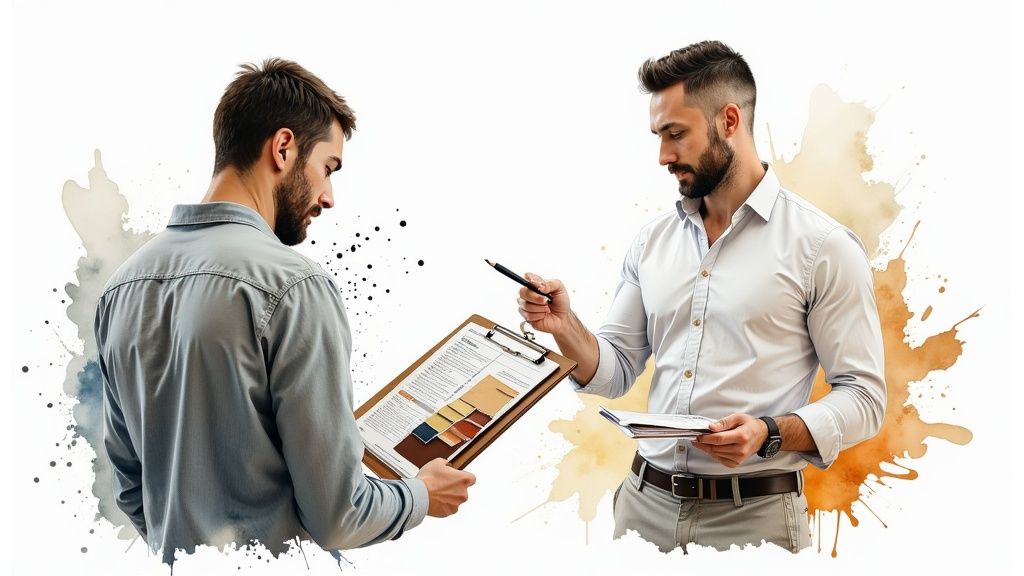
It all starts with the installation. One of the most common—and costly—mistakes we see is installers rushing to lay the flooring the moment it arrives. Rubber and vinyl are sensitive materials; they need time to get used to your gym's specific temperature and humidity. If you skip this, the flooring can expand or contract after it's been laid, leading to ugly buckles, warps, or gaps between the seams.
Actionable Takeaway: Always let your flooring materials acclimate inside the gym for at least 48 hours before installation. This simple step stabilizes the material and prevents future fitment issues that are costly and disruptive to fix.
Creating A Simple Maintenance Schedule
Once your floor is down, a smart maintenance plan is your best defense against the daily grind of a busy gym. A simple, consistent routine is far more effective than waiting to do a massive deep clean every few months. This approach doesn't just keep your facility looking pristine; it dramatically extends the life of your floor.
For a detailed breakdown of daily, weekly, and monthly tasks, this ultimate fitness center cleaning checklist offers an excellent framework to build from.
Here’s a practical schedule you can put into action right away:
- Daily Routine: Get a walk-behind auto-scrubber and use it with a neutral pH cleaning solution. A traditional mop and bucket often just pushes dirty water around, but an auto-scrubber actually lifts and removes the grime, leaving the surface truly clean and hygienic.
- Weekly Tasks: Set aside time to tackle scuff marks from equipment and shoes, especially in high-traffic spots like near the dumbbell racks and under cardio machines. A quick spot treatment with a soft-bristled brush and your neutral cleaner can stop these marks from becoming permanent.
- Monthly Check-up: Do a walkthrough and inspect all the seams on your rubber rolls and the edges of interlocking tiles. Keeping these tight and sealed is crucial. It stops moisture and dirt from creeping underneath, which is one of the main reasons floors fail prematurely.
Common Mistakes That Ruin Gym Floors
Even with the best intentions, using the wrong products or techniques can cause serious, irreversible damage. As more people move to cities—with projections showing 68% of the global population will be urban by 2050—the demand for durable, hygienic gym spaces is only going to increase. Meeting that standard means knowing what not to do.
Steer clear of these critical errors to protect your flooring:
- Using Harsh Chemicals: Never, ever use cleaners with ammonia, bleach, or acidic ingredients. These formulas are poison for rubber and vinyl. They'll make the material brittle, cause discoloration, and weaken the floor over time.
- Applying Excessive Water: Drenching the floor when you clean is a huge mistake. Water is sneaky; it will find its way under tiles and through seams, getting trapped and creating a perfect breeding ground for mold and mildew. This is a floor killer and a serious health hazard.
- Ignoring Proper Dilution: Always follow the manufacturer’s instructions for diluting your cleaning concentrate. If the solution is too strong, it will leave behind a sticky film that actually attracts more dirt, leaving your floor looking perpetually grimy no matter how often you clean it.
For a deeper dive into protecting your investment, check out our guide on gym floor protection for more strategies to keep your facility in top shape.
Your Commercial Gym Flooring Questions Answered
When you're outfitting a gym, the flooring is one of the biggest decisions you'll make. It's the foundation of your entire facility, impacting everything from member safety to the longevity of your equipment. Naturally, a lot of questions come up. We hear them all the time from gym owners, so we've put together some straight-to-the-point answers to help you move forward with confidence.
What Is The Most Durable Type Of Gym Flooring?
For sheer, take-anything-you-can-throw-at-it durability, nothing beats vulcanized rubber. It’s the undisputed champion of gym flooring.
Think of it like the difference between a standard car tyre and a high-performance racing tyre. While both are rubber, one is engineered to withstand extreme stress. Vulcanized rubber goes through a high-heat, high-pressure process that chemically fuses the rubber particles, creating a super-dense, non-porous surface that’s incredibly tough. This process gives it far superior tear resistance compared to standard recycled rubber. It's the go-to solution for the most punishing gym environments where durability is everything.
Real-World Example: A local CrossFit box was burning through money constantly replacing tiles in their Olympic lifting area. Dropped barbells weighing 300+ lbs were tearing and chipping the edges of their standard rubber tiles. After switching to 12mm thick vulcanized rubber rolls, the problem vanished. The flooring absorbed the heavy impacts without breaking a sweat, saving them thousands in the long run.
How Can I Reduce The Rubber Smell In My New Gym?
Ah, that "new gym smell." It's a common side effect of new rubber flooring, caused by a process called off-gassing. While it's only temporary, a strong odor can definitely put a damper on the member experience. The good news is you can speed up the process and clear the air much faster.
Here's an actionable plan to eliminate the odor quickly:
- Step 1: Maximize Airflow: For the first 48-72 hours, get as much air moving as possible. Open all the doors and windows and use industrial fans to create a cross-breeze. This actively pulls the volatile organic compounds (VOCs) that cause the smell right out of the room.
- Step 2: Do an Initial Deep Clean: As soon as it's installed, mop the entire floor with warm water and a mild, pH-neutral degreaser. This washes away any surface oils left over from manufacturing that contribute to the smell.
- Step 3: Choose Low-Odor Products: When you're buying your flooring, ask about "low VOC" or "low odor" options. These are made using processes that minimize off-gassing right from the start. The benefit is a better member experience from day one.
Can I Install New Gym Flooring Over An Existing Floor?
This is a classic "it depends" situation. Sometimes you can, but often it's a bad idea. Whether you can lay new flooring on top of an old surface depends entirely on what's already there and what condition it's in. A shaky foundation will sabotage your new investment, leading to bumps, bubbles, and a floor that fails way too soon.
Here’s a simple checklist to decide:
- It might work if the existing floor is: Vinyl Composition Tile (VCT) or linoleum that is perfectly flat, solid, and shows zero signs of moisture damage or cracking.
- It's a bad idea if the existing floor is: Carpet (especially plush carpet), cracked concrete, or damaged tiles. The soft or uneven base will cause seams to pull apart and tiles to shift under pressure. The benefit of removing a bad subfloor is avoiding a costly re-installation down the road.
What Is The Best Way To Clean And Disinfect Gym Flooring?
Keeping your gym hygienic is non-negotiable for member health and happiness. But using the wrong chemicals can destroy your flooring and even void its warranty. You need a cleaning routine that is tough on germs but gentle on your floor.
- How-To: The gold standard is a neutral pH, EPA-approved disinfectant cleaner. These cleaners are made specifically to kill germs, bacteria, and viruses without the harsh chemicals like bleach or ammonia that eat away at rubber and vinyl.
- Benefit: By using the right product, you protect your flooring's warranty, extend its lifespan, and provide a verifiably safe and hygienic environment for your members. To get your cleaning routine down to a science, check out our complete guide on how to clean gym mats safely and effectively.
By sticking to the right products and a consistent schedule, you’ll ensure your commercial gym flooring stays clean, safe, and looking great for years.
Ready to build a safer, more durable, and more impressive fitness facility from the ground up? Mats4U offers a wide selection of high-performance commercial flooring solutions designed to meet the demands of any gym environment.
Explore our complete collection of commercial gym flooring solutions at Mats4U



